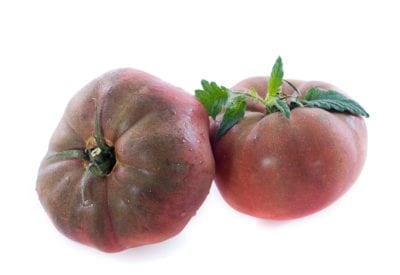
Black Krim tomato plants produce large tomatoes with deep reddish purple skin. In hot, sunny conditions, the skin turns nearly black. The reddish green flesh is rich and sweet with a slightly smoky, homegrown flavor.
A type of indeterminate
tomato, growing Black Krim tomatoes requires about 70 days from transplant
to harvest. If you are interested in growing Black Krim tomatoes in your garden
this year or next season, read on to learn how.
Black Krim Tomato Facts
Also known as Black Crimea, Black Krim tomato plants are
native to Russia. These tomato
plants are considered heirlooms,
meaning the seeds have been passed down from generation to generation.
Some growers will say heirloom plants are those that have
been passed down for at least 100 years while others say 50 years is sufficient
time to be considered an heirloom. Scientifically, heirloom tomatoes are open
pollinated, which means that, unlike hybrids, the plants are pollinated
naturally.
How to Grow Black Krim Tomatoes
Purchase young Black Krim tomato plants at a nursery or
start seeds indoors about six weeks before the last expected frost in your
area. Plant in a sunny location when all danger of frost has passed and soil is
warm.
Dig 2 to 4 inches (5-10 cm.) of manure
or compost into the soil before planting. You can also apply a small amount of
general-purpose fertilizer
according to label recommendations.
To grow a strong, sturdy plant, bury up to two-thirds of the
stem. Be sure to install a trellis, stakes,
or tomato
cage, as Black Krim tomato plants require support.
Black Krim tomato care is really no different than with any other type of tomato. Provide growing tomatoes with 1 to 2 inches (2.5-5 cm.) of water each week. The goal is to maintain even soil moisture, helping to prevent blossom rot and cracked fruit. Water at the base of the plant if possible, using drip irrigation or a garden hose.
A layer of mulch,
such as shredded leaves or straw, will conserve moisture and help control
growth of weeds. Side dress plants with a small amount of balanced fertilizer
at four and eight weeks after transplanting. Don’t overfeed; too little is
always better than too much.
Black Krim tomato plants produce large tomatoes with deep reddish purple skin. In hot, sunny conditions, the skin turns nearly black. The reddish green flesh is rich and sweet with a slightly smoky, homegrown flavor.
A type of indeterminate
tomato, growing Black Krim tomatoes requires about 70 days from transplant
to harvest. If you are interested in growing Black Krim tomatoes in your garden
this year or next season, read on to learn how.
Black Krim Tomato Facts
Also known as Black Crimea, Black Krim tomato plants are
native to Russia. These tomato
plants are considered heirlooms,
meaning the seeds have been passed down from generation to generation.
Some growers will say heirloom plants are those that have
been passed down for at least 100 years while others say 50 years is sufficient
time to be considered an heirloom. Scientifically, heirloom tomatoes are open
pollinated, which means that, unlike hybrids, the plants are pollinated
naturally.
How to Grow Black Krim Tomatoes
Purchase young Black Krim tomato plants at a nursery or
start seeds indoors about six weeks before the last expected frost in your
area. Plant in a sunny location when all danger of frost has passed and soil is
warm.
Dig 2 to 4 inches (5-10 cm.) of manure
or compost into the soil before planting. You can also apply a small amount of
general-purpose fertilizer
according to label recommendations.
To grow a strong, sturdy plant, bury up to two-thirds of the
stem. Be sure to install a trellis, stakes,
or tomato
cage, as Black Krim tomato plants require support.
Black Krim tomato care is really no different than with any other type of tomato. Provide growing tomatoes with 1 to 2 inches (2.5-5 cm.) of water each week. The goal is to maintain even soil moisture, helping to prevent blossom rot and cracked fruit. Water at the base of the plant if possible, using drip irrigation or a garden hose.
A layer of mulch,
such as shredded leaves or straw, will conserve moisture and help control
growth of weeds. Side dress plants with a small amount of balanced fertilizer
at four and eight weeks after transplanting. Don’t overfeed; too little is
always better than too much.
